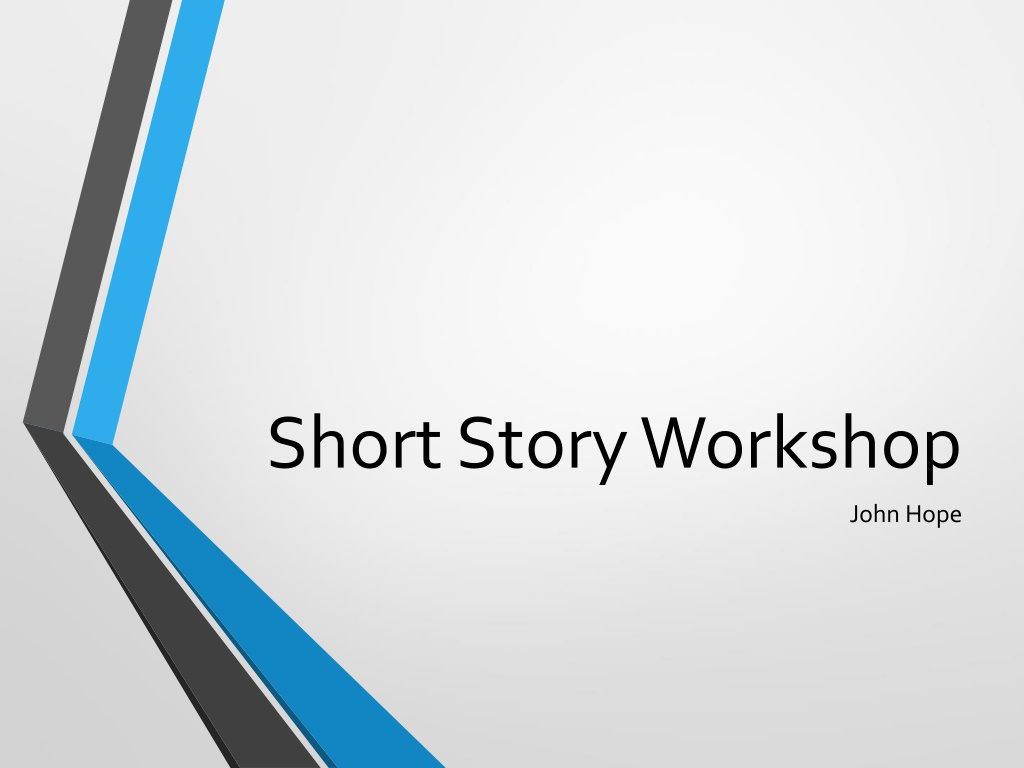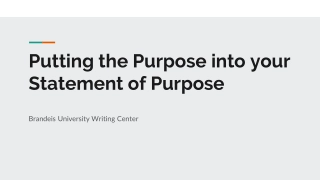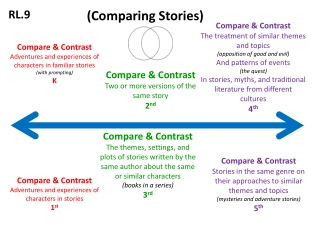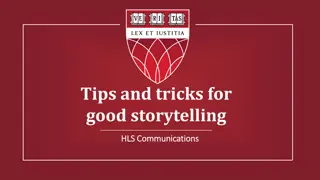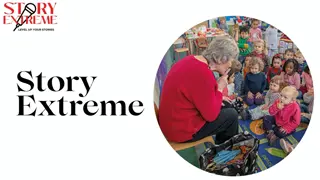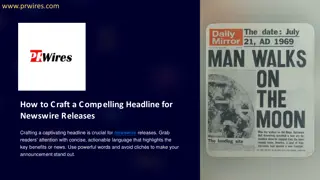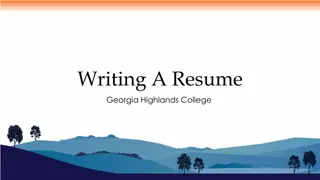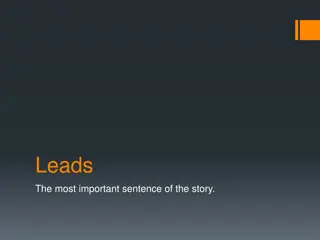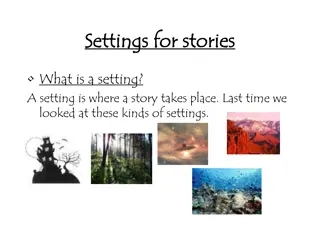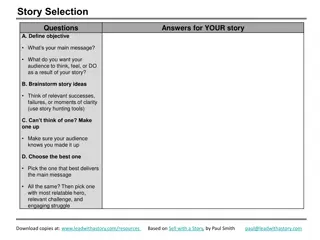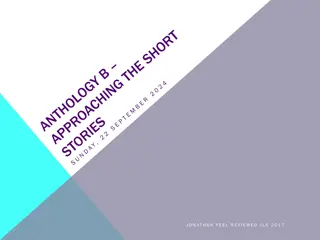Crafting Compelling Short Stories Workshop
Explore the art of crafting short stories with a focus on structure, characters, conflict, and more. Learn how to create a complete narrative within a limited word count while honing your storytelling skills.Tips on establishing characters, developing conflict, and structuring scenes are covered in detail. Discover the nuances of short fiction versus novels and the importance of selecting a key moment in your story. Enhance your writing prowess and unlock the potential of your short stories.
Download Presentation

Please find below an Image/Link to download the presentation.
The content on the website is provided AS IS for your information and personal use only. It may not be sold, licensed, or shared on other websites without obtaining consent from the author.If you encounter any issues during the download, it is possible that the publisher has removed the file from their server.
You are allowed to download the files provided on this website for personal or commercial use, subject to the condition that they are used lawfully. All files are the property of their respective owners.
The content on the website is provided AS IS for your information and personal use only. It may not be sold, licensed, or shared on other websites without obtaining consent from the author.
E N D
Presentation Transcript
Short Story Workshop John Hope
Short Story Workshop Agenda Writing Overview The Short Story Structure Characters Conflict BREAK Description and Dialog BREAK The Dreaded Re-write Summary 9:00am 10:30am 10:30am 10:45am 10:45am 12:00pm 12:00pm 1:00pm 1:00pm 2:15pm 2:15pm 2:30pm 2:30pm 3:45pm 3:45pm 4:00pm Teach Break Teach Lunch Teach Break Teach Closing
Writing Overview The rules of writing (from this course and others) Listen to them Consider them Try them Then, break the rules Key to excellent writing: Give your story what it needs
The Short Story Structure What defines a short story? Often between 1k to 5k words, less than 20k Contains a COMPLETE story Main conflict resolution Character arc Rich with scene and character description and dialogue RPLA Guidelines Short fiction has many of the elements of a novel, including character, setting, plot, conflict, resolution, climax, dialogue, protagonist, and antagonist. Maximum 8,000 words
Short Stories vs Novels Similarities Plot curve Characters Setting Differences In Novels, scenes are steps toward the resolution Short Stories have little to no exposition and its primary focus is resolving ONLY the main conflict
Short Stories Focus on a Key Moment In order to fit the story within a limited number of words, select the tipping point
Short Stories Establish basic elements before writing 1. Character(s) Make them interesting and believable Combine unusual characteristics 2. Conflict Character WANTS something, but something or someone is in the way 3. Scene Many short stories have one scene, make it good and interesting
Characters What makes good characters? Definition Depth Heart
Characters - Definition What they re named Names are readers first impression Darth Vader, Scout, Harry Potter, Scarlett O'Hara Avoid main character names with the same first letter What they look like Readers need a visual Helps to separate characters in readers minds
Characters - Definition What they do Distinctive quarks What they say Distinctive speech What they think Creative, funny, odd, stupid, insane, etc.
Characters - Definition What readers like in characters Has flaws Humble Good character (dependable / keep promises / honest) Live by morals / standards Helpful / compassionate (esp. for certain people) Funny / sense of humor Courageous, yet shows fear Relatable goals Down to Earth / level-headed / even-tempered Smart Cool (esp. in tense moments)
Characters - Definition What readers don t like in characters Perfect Liar / undependable / carelessly breaks promises Brags / sees themselves as superior Unsportsmanlike / unfair Self-serving Not funny / bad sense of humor Hidden cowards Unworthy goals Extreme behavior / mood swings Bullies others Whines and complains Panics under pressure
Characters - Want ALL characters should want something (desire/goal) If a character doesn t want something, he/she doesn t belong in your story The stronger the want, the better Needs: Air Wants: To Live
Characters - Depth Secrets / Something under the surface Example: Leader of AA meetings hides liquor for himself Contradiction Example: Black-wearing, goth-like, yet loves butterflies Example: Fights for equality, yet fiercely competitive Personal History Background Past struggles / conquests Past relationships Deep-seeded interests, desires Leads to a vulnerability
Characters - Depth http://www.ferdyonfilms.com/wp-content/uploads/2010/05/Conan3-e1273251348106.jpg Boy Enslaved Resentment Builds Boy into Warrior Bad Guy Kills Mommy http://www.ferdyonfilms.com/wp-content/uploads/2010/05/Conan6-e1273251225838.jpg Revenge
Characters - Depth Vulnerability Achilles heel
Characters Group Activity Character 1
Characters Group Activity Character 2
Conflict Foundation of all storytelling is conflict Conflict = Story No Conflict = No Story Definition of Conflict (from a story s perspective) A character wants something, but something is in the way of getting what he/she wants
Conflict What s the source of conflict? What s at stake?
Source of Conflict The Four Types of Conflict Character-vs-Character Character-vs-Self Character-vs-Nature Character-vs-Society People Situation
Source of Conflict People Conflict (Character-vs-Character) Understanding why people conflict with each other will allow you to build good scenarios Primary reason for Person-to-Person Conflict: MISCOMMUNICATION
Classic Miscommunication Juliet faked her death Romeo thought she was dead, killed himself When Juliet awoke and found Romeo dead, she killed herself
Miscommunication C A Talking to the Road Runner Talking to Wile E. Coyote D B Understanding Wile E. Coyote Understanding the Road Runner
Source of Conflict People Conflict (Character-vs-Self) Both Good Guys and Bad Guys should think they are right, based on their personal objectives/morals
Source of Conflict Situation Conflict (Character-vs-Nature) Can be very compelling since obstacles and situations often cannot be defeated or changed easily Terry Fox Embarked on a cross-Canadian run Ran for 143 days, covering 3,339 miles before he died
Source of Conflict Situation Conflict (Character-vs-Society) Fighting the norms of society, or a specific group Martin Luther King Jr Pushed for peaceful reforms Gave Inspiration to Millions
Conflict Up against a wall When characters face resolution to their conflict, they often must ask themselves the following question: What is most important to him/her?
Whats at Stake? Novels What s at stake develops gradually through the course of the story Short Stories The stakes may develop, but they need to rise quickly In both cases: The Bigger the Better!
Whats at Stake? A Christmas Carol: Ebenezer Scrooge At Stake: Wasting His Life, Tiny Tim s Life, Bob Cratchit s Family, Ebenezer s Nephew Lord of the Rings: Frodo At Stake: The Fate of Middle Earth
Conflict Activity 1 Identifying Conflict Green Eggs and Ham Character-vs-Character Character-vs-Self Character-vs-Nature Character-vs-Society What? Why?
Conflict Activity 2 Identifying Conflict Comic Character-vs-Character Character-vs-Self Character-vs-Nature Character-vs-Society What? Why?
Conflict Activity 3 Creating Conflict Character-vs-Character Character-vs-Self Character-vs-Nature Character-vs-Society What? Why? Verses
Description and Dialog Description and Dialog Both paint the picture of the characters and their world Warning! Too much of either can drown your story Every sentence must do one of two things reveal character or advance the action. Kurt Vonnegut
Description The power of Less is More Using fewer, more powerful words makes writing stronger Example: Jesus wept. - John 11:35
Description Efficiency in Descriptions Rather than going overboard with flowery language, select the best details, and then move on Bad Example In this day and age, lazy, sloth-like young people hang out inside the house doing absolutely nothing literately all day. Revised Now days, kids are lazy. They play video games instead of kickball.
Description The Description Rules Be specific, Avoid ambiguity Bad: Sally ate a pastry. Good: Sally ate a jelly donut. Use action verbs Bad: Jeff went to the kitchen. Good: Jeff skipped to the kitchen. Avoid adverbs and passive voice Bad: Mary was dutifully taken to school. Good: Mom drove Mary to school every day.
Description The Description Rules Use senses (sight, sound, taste, touch) Bad: Kevin saw the machine in the garage. Good: With repeating clanging pistons and a whiff of burning oil, Kevin felt at home in a stuffy garage. Use appropriate language / descriptions Bad (maybe): Four-year-old Katie thought the piece of cake towered on her plate like the Leaning Tower of Pisa. Good: Four-year-old Katie thought the piece of cake was bigger than Daddy s head.
Description The Description Rules Avoid duplicating descriptions Bad: Allister had a huge, enormous, big zit on his nose. Good: Allister had an enormous zit on his nose. Bad: Betty s noisy cat was louder than a fire alarm. Good: Betty s cat was louder than a fire alarm. Avoid repurposing words Bad: Zach looked at Tom he looked surprised. Good: Zach noticed Tom was surprised. Better: Zach noticed Tom s raised eyebrows and dropped jaw.
Description Activity 1 1. Mr. Stevens, who was my former neighbor, won his lawsuit. 2. There is a chat area on the Web called Study Hall that encourages students to talk with one another about college courses. 3. He carries a briefcase made out of leather. 4. He carries a briefcase made out of leather that is weather- beaten. 5. The company is taking applications at this point in time.
Description Activity 2 1. Be Specific 2. Action Verbs 3. Use Senses
Dialog Give each character a language (one or more of the following or some other distinctive quality): Dialect / mispronunciations (just enough) Use specific words / phrases Elegant wording verses short/choppy Repeated expressions Misuse of words Be true to your characters Keep the plot moving, always Avoid babbling dialog
Dialog The Don ts Info Dumps Repeated Long-winded Monologues Too Much Unreadable Dialect Too Much Info Unrelated to Anything Too Much Talking, Not Enough Action Melodramatic Expressions and Dialog Tags: Get me a glass of milk! Mom exclaimed. We re out of milk! Jimmy retorted. Oh, no! For milk is the source of life! Mom belted. I know! Susie quipped. I ll dash to the store!
